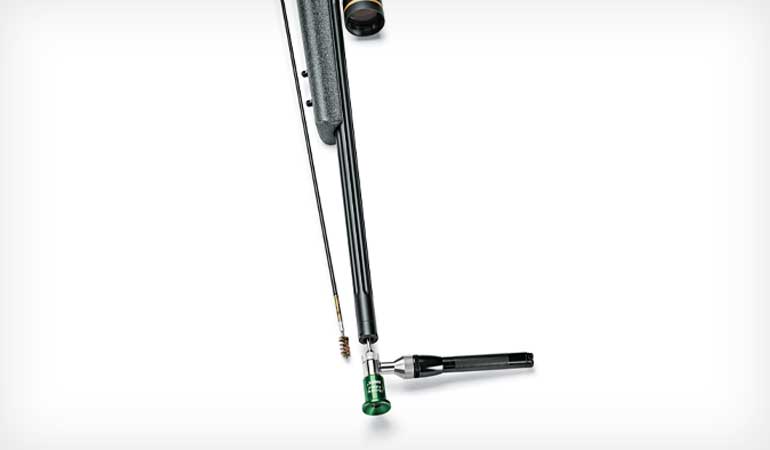
When the first practical smokeless rifle powders appeared in the 1880s, the higher velocities proved to be too fast for traditional lead bullets, so lead cores were encased in harder metals. The most practical jackets turned out to be copper alloys, with cupronickel a popular early choice. Cupronickel is 75 percent copper and 25 percent nickel, the same mix found in American five-cent coins, which oddly enough looks “silver.”
Unfortunately, cupronickel fouling built up quickly, affecting accuracy, and proved difficult to remove. Many early military cartridges used cupronickel jackets, including those known to civilians as the 8×57 Mauser, .30-40 Krag, and .30-06 Springfield. Col. Townsend Whelen described how the buildup was finally solved by plugging barrels and filling their bores with a strong ammonia solution, dissolving the copper.
A mild brass eventually became the predominant choice. Consisting of 90 to 95 percent copper and 5 to 10 percent zinc, “gilding metal” proved to be easier to remove from rifle bores, with fouling normally thin enough that legendary gun writer Elmer Keith called it “copper wash,” saying he’d rarely seen it affect accuracy.
However, when gilding metal became the standard jacket material, many shooters became lax about cleaning bores, particularly after the 1920s, when non-corrosive primers started replacing mercuric primers. Most simply brass-brushed their bores with mild solvents, the technique most “experts” advised when I started shooting centerfire rifles in the late 1960s.
Occasional brushing works with some rifles, but not all. A decade ago, Jay, a friend, phoned one evening, asking if the barrel might be shot out on his .270 Weatherby Magnum Winchester Model 70 Classic. The rifle wasn’t grouping nearly as well as usual. He knew I owned a borescope, so could we take a look at the throat? He guessed he’d fired about 500 rounds in the rifle, while working up handloads, practicing, and hunting for the past several Montana big-game seasons. I suggested he drop it off on his way to work the next morning.
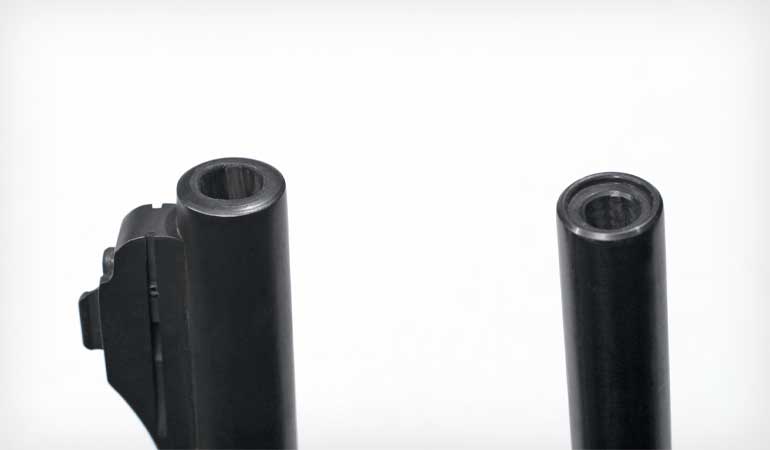
Chamber-throat erosion normally begins in front of the neck, where powder gas burns hottest. My borescope showed only a hint of erosion, not enough to affect accuracy, but the bore appeared plated with copper. I tried a powerful ammonia solvent, reapplying with a new cotton patch every 15 minutes, but each patch only revealed yet another “geologic” layer of copper, between light powder fouling.
Eventually, I gave up and opened a jar of JB Compound, an abrasive paste that wears away fouling. I smeared some on a couple of cotton patches wrapped around a bore brush and stroked the brush back and forth through the bore for 20 minutes. That did the trick.
When Jay showed up after work I asked, “You ever clean this rifle?”
He frowned. “Of course.”
It turned out he brush-scrubbed the barrel once a year, then ran cotton patches through the bore until they came out “clean.” I suggested he shoot the rifle and report back. He called an hour later, ecstatic because it “shot like new.”
While many hunters clean their rifles infrequently, like Jay, many avid shooters clean their rifles after every time they shoot. Often this is a holdover from the corrosive primers and dirty-burning spherical powders used in a lot of military ammo during much of the 20th century, but benchrest shooters usually clean after every shooting session because they’re convinced clean barrels shoot most accurately.
They’re probably right—when 100-yard, five-shot groups have to form one ragged hole to contend in major matches. However, many longer-range target shooters don’t clean their barrels nearly as frequently because they’ve found “fouled” barrels result in lower muzzle velocity variations, which is more important at several hundred yards than groups a fraction of an inch smaller at 100 yards.
Whether any of this applies to hunting rifles depends on what we’re hunting. Shooting prairie dogs at several hundred yards obviously requires finer accuracy than minute-of-moose.
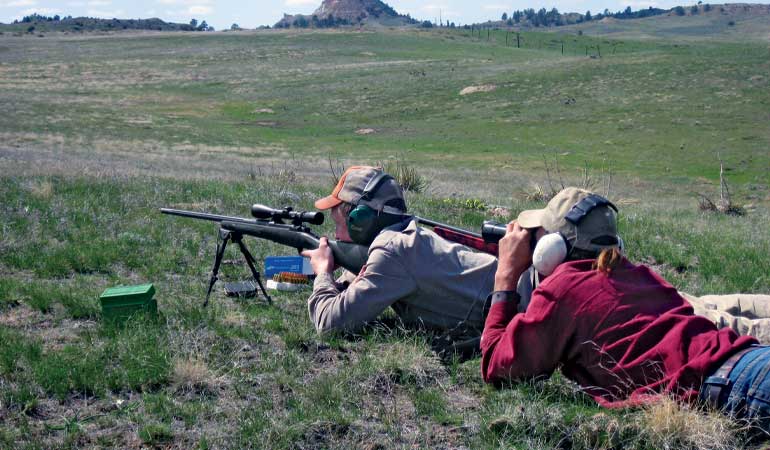
Personally, I hate cleaning rifles, having discovered long ago they’re more fun to shoot than clean. In the mid-1970s I started recording the number of rounds fired through each of my rifles, along with when each barrel got cleaned. Back then, benchrest shooting had such an influence that many of the same experts advising Jay-style rifle “cleaning” also advised scrubbing every 20 to 25 rounds, supposedly how often benchrest shooters cleaned rifles.
Inevitably, of course, some of my barrels happened to go 40 or even 50 rounds between cleanings. This usually didn’t make any difference in accuracy, especially with the first rifle I ever actually shot out: a Remington Model 700 in .270 Winchester. That rifle was one of the most accurate big-game guns I’ve ever owned. Its most accurate handload, the original “war surplus” H4831 powder combined with the Hornady 150-grain Spirepoint, grouped three shots into an inch or so at 300 yards. I took a lot of big game with that rifle, but I shot far more holes in paper, because of dumb fascination with tiny groups.
Eventually, recording cleaning intervals resulted in knowing how many rounds each of my rifles could go between scrubbings and still maintain accuracy. Very few shot measurably worse after 25 rounds, one being the actual benchrest rifle I eventually purchased (a 6mm PPC made by local gunsmith Arnold Erhardt).
Most rifles would go 60 to 75 rounds between cleanings without a measurable difference in accuracy, and a few lasted 100 or even far more. One rifle continues to shoot accurately without even being shown a cleaning rod for at least 500 rounds. I don’t actually know how long it might go without cleaning because I always scrub the bore at around 500 rounds…just because. The barrel’s never shown more than the faintest hint of copper fouling and after cleaning shoots worse for a group or two before returning to normal.
This barrel is not a handlapped custom. It’s the heavy-contour factory barrel on a .223 Remington Model 700 BDL purchased at a local store in 2001. I bought the rifle to shoot varmints but also to experiment with accuracy handloading techniques.
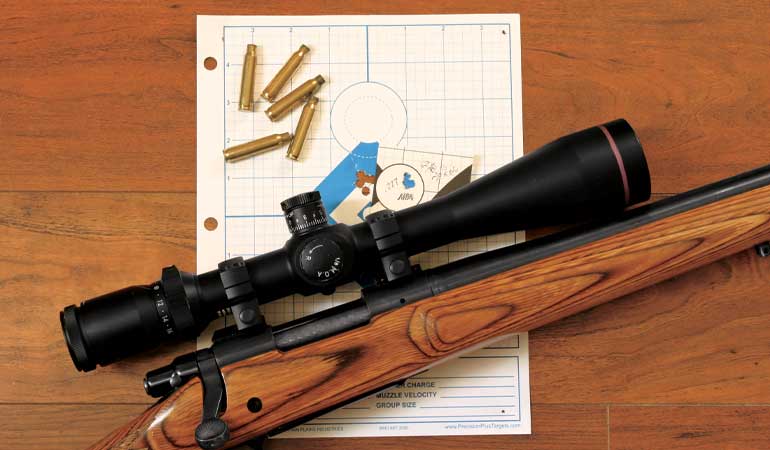
Examples & Solutions
Not long afterward, I purchased a Gradient Lens Hawkeye borescope, since obviously the insides of rifle barrels affect accuracy. Looking through either end of a barrel with our naked (or spectacled or contact-lensed) eye reveals very little information, except whether the rifling right behind the muzzle is copper fouled or the bore is really rough, whether due to toolmarks, corrosion, or erosion.
Many shooters assume the primary purpose of a borescope is to pick good barrels, but they obviously don’t own borescopes. Anybody who buys one soon discovers that some pretty rough bores shoot very well and some very smooth bores don’t. My .223’s barrel wasn’t exactly rough, but the borescope revealed reaming marks not visible to my bifocaled eye. Yet, with really precise handloading techniques and a 6-24X riflescope, the rifle averaged five shots in a quarter-inch at 100 yards. After a few thousand rounds of prairie-dog shooting, it’s more of a half-inch rifle, but it still refuses to copper foul.
At the other extreme was the second barrel on my .338 Winchester Magnum rifle that was built in the late 1980s on a commercial FN Mauser action. The custom barrel shot okay, but not great, and a few years later was replaced by a Sako factory take-off barrel I purchased at a gun show because I knew Sako barrels shot very well.
This one grouped three shots from most bullets into less than an inch at 100 yards, sometimes much less, but after 20 rounds the bore acquired so much copper fouling groups started opening up. Solvents took too long, so JB Compound became my standard solution. However, within a couple of years the bore started fouling even more—and quicker.
I shot that .338 a lot back then, partly due to hunting considerably while handloading and field-testing various bullets and partly due to testing new scopes because a relatively light .338 quickly reveals any scope problems. Even molybdenum disulphide (“moly”) coating on bullets didn’t help much. Among the bullets tested was the then-new 230-grain Fail Safe, molycoated at the factory. They still coppered the bore, though perhaps a little slower than uncoated bullets.
Eventually, I considered rebarreling the rifle, but luckily another solution appeared. On a hunt in Texas I met a guy named Doug Burche, who worked for a company producing several innovative firearms coatings, all based on fine silica powder. One called Micro-Slick consisted of a thin, quick-drying glue containing the silica. Applied to a perfectly clean, dry bore, the heat and pressure of firing “cured” the silica into an ultra-thin layer, which Burche claimed greatly reduced copper fouling.

A test sample saved my .338’s barrel. After firing the curing shots, I cleaned the bore again because during curing the bore still tends to foul. I then shot 20 rounds of the rifle’s most accurate handload (a Nosler 200-grain Ballistic Tip with 65.0 grains of Alliant Reloder 15). It grouped well throughout the string and left noticeably less copper in the bore. I reported this to Burche, who said a second application sometimes helped heavy-fouling bores. After cleaning with an ammonia solvent (JB Compound was no longer required), applying another layer of Micro-Slick, and firing 75 rounds, my borescope showed only slight “copper wash” along the edges of the lands.
The coating’s now named Dyna-Tek Bore-Coat, usually called DBC by shooters, and a one-ounce bottle treats a number of rifles. I’ve installed DBC in more than two dozen barrels, primarily but not exclusively on varmint rifles used for high-volume shooting. Normally, a single coating allows me to never clean barrels while prairie dog hunting.
“Fire-lapping” barrels with abrasive-coated bullets also reduces copper fouling, but primarily smooths the bore near the chamber and can change throat dimensions considerably. I primarily fire-lap barrels roughened by throat erosion, where the borescope allows me to observe exactly when the “gator skin” disappears.
Many other solutions have been used to prevent or reduce copper fouling. In the days of cupronickel jackets, many shooters (including Whelen) coated bullets in loaded ammo with a grease named Mobilubricant.
Moly became the “in” coating about a century later. I used moly considerably not only on Fail Safes but also on varmint bullets, and while it definitely reduces copper fouling, the moly itself tends to build up inside the bore, affecting accuracy. Knocking the buildup down with a few strokes with a dry brush normally solves the problem, but moly (like Mobilubricant) has to be applied to every bullet, like another recent anti-fouling coating: boron nitride.
Personally, due to the same laziness that makes me avoid cleaning rifles, I prefer coating the bore once with DBC to coating a bunch of bullets. When DBC was first introduced, it looked like it might be a permanent solution, but now Dyna-Tek suggests rifles shot a lot might need an annual application. In most big-game rifles, however, DBC basically lasts forever. I’ve fired my .338 over 300 times since installing it and cleaned the bore only four times.
Improved powders also help prevent copper-fouling problems. This includes newer spherical powders that often burn much cleaner than older sphericals. Their burn rate is controlled by retardant coatings, which by definition resist, on the granules. Most early spherical powders left considerable dark residue inside bores, but many newer sphericals use improved coatings, leaving far less powder fouling. Among these powders is the Ramshot line, originally developed for automatic firearms. When I bought my non-fouling .223 Remington Model 700 BDL, Ramshot TAC had just appeared on the scene, and it left only a hint of powder fouling after 500 rounds.
Many newer powders also contain “decoppering” agents. These powders include the IMR Enduron powders; Alliant Reloder 16, 23, and 26; and all VihtaVuori rifle powders. Many shooters assume decoppering powders are a new development, but they appeared over a century ago, when powder charges of artillery shells were topped with lead foil or wire. During firing, the lead combined into a brittle amalgam with copper fouling, which was blown out of the barrel.
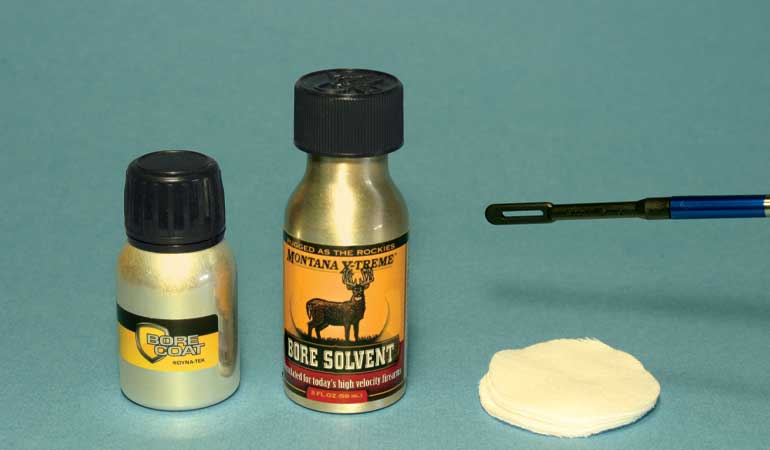
Tin and bismuth work the same way and have been added to some military small arms powders for a long time. A few of these military powders made the transition to the civilian market after World War II, but nobody made a big deal about their decoppering qualities.
The recent trend toward long, high-ballistic-coefficient bullets with plenty of bore contact tended to increase copper fouling, which is one reason more powders now contain decoppering agents—though not lead, which today is considered a dangerous pollutant. And, yes, decoppering works, as my borescope has revealed to me many times. At the very least, they greatly reduce copper fouling and often eliminate it completely.
Unfortunately, we sometimes must still clean rifle bores, and a borescope also helps determine the effectiveness of various cleaning products. I’ve tried a bunch over the years, including the battery-powered Outers Foul Out system that requires filling the bore with electrolytic liquid around a stainless-steel rod. It works but makes me sympathize with Whelen plugging and filling cupronickeled rifle bores with ammonia solution every evening so he could shoot accurately the next day. In my expereince, Foul Out has been far more hassle to use on heavily fouled bores than JB Compound and not any more effective.
I’ve also experimented with “lifter” cleaners that creep under copper fouling and separate it from the bore. These work well on relatively light copper wash but, in my experience, not so well with heavier fouling.
Classic ammonia/water solutions require reapplication with a fresh patch every 10 to 15 minutes to prevent oxidation of the ammonia, which can etch the bore and increase the tendency to foul. Luckily, several companies now offer oil-based ammonia cleaners that can be left in the bore indefinitely without any danger of bore etching. The two brands I’ve used most are Montana X-Treme and Wipe-Out, and I often leave them in a rifle bore overnight. They work very well in dry Montana, but thanks to friends across the country who also own borescopes, I’m convinced other copper solvents can work just as well, if not better, in more humid regions.
A borescope also reveals how much fouling results from various bullets, along with where a bore fouls. Many shooters assume that if the bore is copper-free at the muzzle, then it’s not fouled anywhere. Unfortunately, most copper fouling tends to occur just in front of the chamber, where the bullet is forced into the rifling. However, this is not a hard rule, and barrels can decide to foul anywhere. My latest is a handlapped Lilja in 6.5 PRC, and it only copper fouls slightly from 3 to 6 inches inside the muzzle, primarily with one brand of bullet, so I don’t use that bullet. (Luckily, it’s not the most accurate in my rifle.)
With today’s barrels, powders, and bore products, copper fouling isn’t nearly the time-consuming problem it used to be, and that leaves us more time to shoot!








